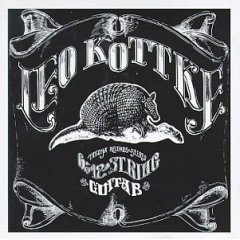Top Qs
Timeline
Chat
Perspective
6- and 12-String Guitar
1969 studio album by Leo Kottke From Wikipedia, the free encyclopedia
Remove ads
6- and 12-String Guitar is the second album by Leo Kottke, a solo instrumental steel-string acoustic guitar album originally released by John Fahey's Takoma Records in 1969. It is popularly known as the Armadillo album after the animal illustrated in the distinctive cover art (by Annie Elliott). Although Kottke has had a prolific career as a recording artist, 6- and 12-String Guitar remains his best-known album.
Remove ads
History
Summarize
Perspective
The album showcases Kottke's early, hard-driving polyphonic finger-picking style (which eventually led to his developing tendinitis and having to change his playing approach).[1] Even at the fastest tempos the notes are clean and crisp, with a distinctive tone. The album was recorded in one afternoon, in exactly the running order of the album. Most tracks were done in a single take. Kottke doesn't even pause when he audibly smacks the slide on the guitar neck on "The Sailor's Grave on the Prairie." In the liner notes to Anthology he states, "We didn't know about sequencing, so the record is in the order it was recorded...The record took three-and-a-half hours to do, and all I had to do was sit down and play everything I ever knew."[2]
True to its title, the album contains performances on both 6- and 12-string acoustic guitars, some using a slide. Although Kottke has included vocals on other albums, this album is all instrumental – the reason being, as Kottke explains in the liner notes, his voice "sounds like geese farts on a muggy day."
All the tracks were written by Kottke except Jesu, Joy of Man's Desiring, Kottke's arrangement of the familiar Bach piece.
The album had a large influence on, and was an inspiration for, guitarist Michael Hedges, who would later tour with Kottke.[3]
This album has been re-released as an SACD.
Remove ads
Reception
AllMusic critic Richie Unterberger wrote of the album, "Kottke's brand of virtuosity, however, is more soothing and easy on the ear than Fahey's. It's far from sappy, though, the rich and resonant picking intimating some underlying restlessness, like peaceful open fields after a storm. Establishing much of the territory Kottke was to explore throughout his career, this release was also one of his most popular, eventually selling over 500,000 copies."[4] Rolling Stone brought the album to a wider public with its review in 1970 by Carl Bauer, in which he wrote: "With all the shit that has been released recently, it was a distinct pleasure to come across this album... Kottke isn't a new addition to the Page-Beck school of grating, hypertensive guitarists, as if you were expecting that. He's an acoustic guitarist from Minneapolis whose music can invoke your most subliminal reflections or transmit you to the highest reaches of joy... anything in addition to his guitar would be superfluous."[5]
Remove ads
Track listing (with Kottke's notes)
Summarize
Perspective
Side One
All tracks are written by Leo Kottke, except where noted.
Side Two
Remove ads
Personnel
- Leo Kottke – 6- & 12-string guitars
Cover design by Annie Elliott (who also did the cover for 12-String Blues)
References
External links
Wikiwand - on
Seamless Wikipedia browsing. On steroids.
Remove ads

